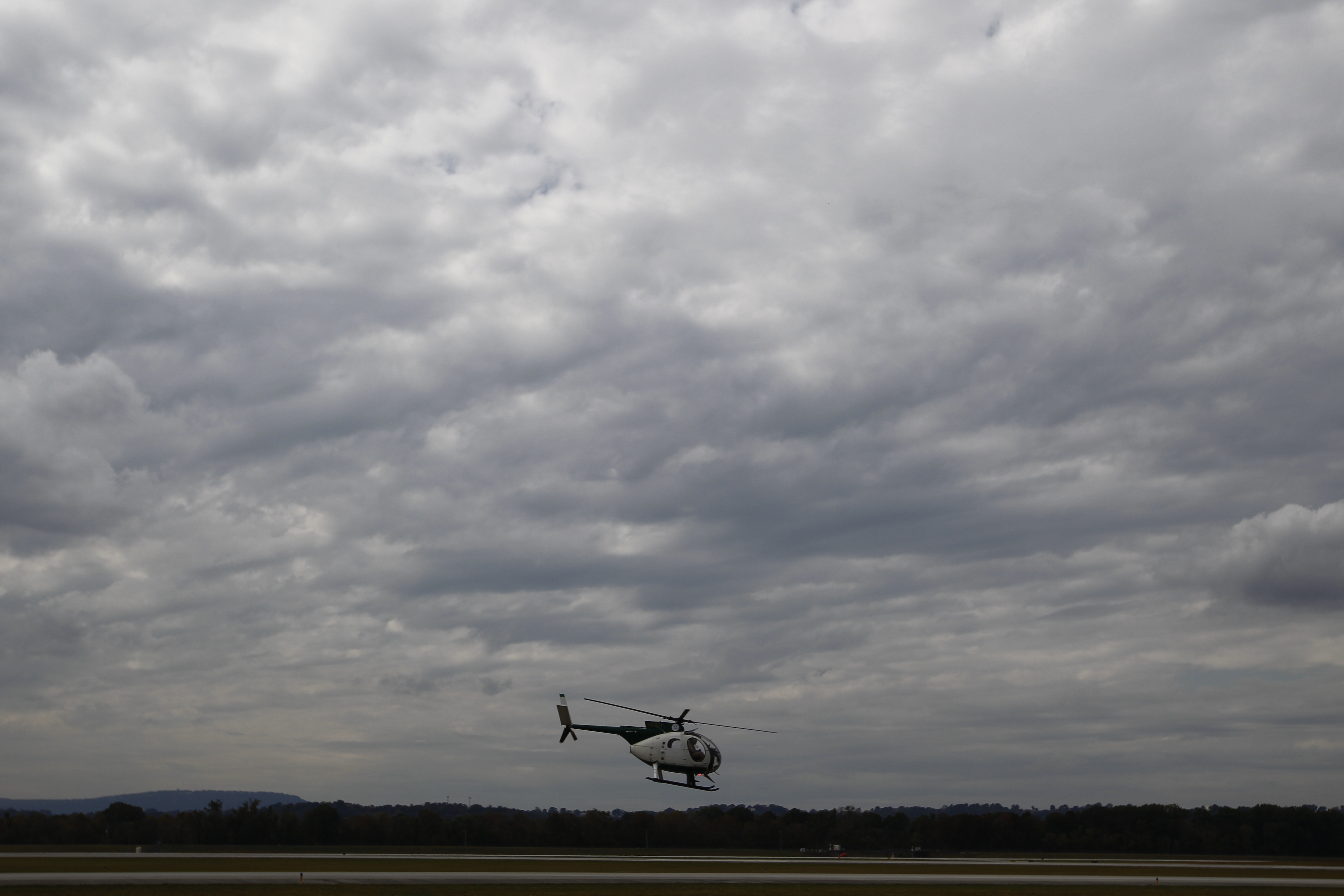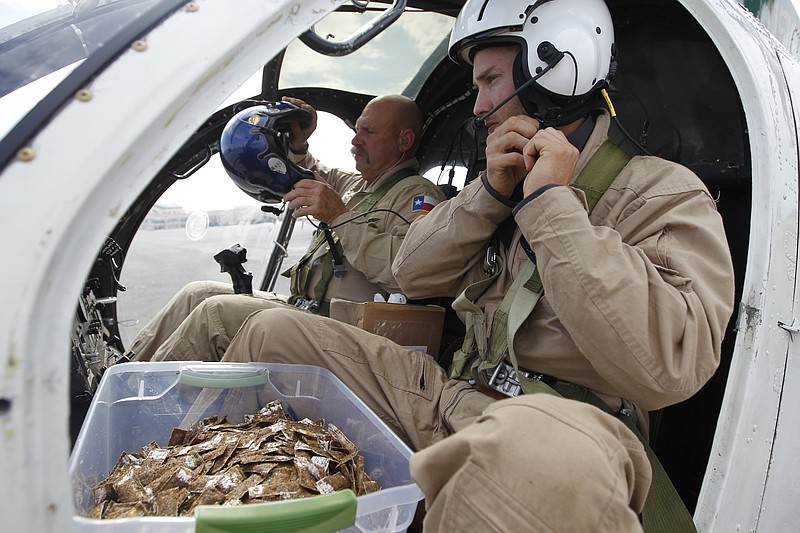 A USDA helicopter takes off Tuesday, Oct. 22, 2013, from Chattanooga Metropolitan Airport's Lovell Field in Chattanooga, Tenn., to distribute baited packets of rabies vaccine. The USDA is spending several days dropping bait-coated packets of rabies vaccine from a helicopter across Hamilton and Bradley Counties to combat rabies in raccoons.
A USDA helicopter takes off Tuesday, Oct. 22, 2013, from Chattanooga Metropolitan Airport's Lovell Field in Chattanooga, Tenn., to distribute baited packets of rabies vaccine. The USDA is spending several days dropping bait-coated packets of rabies vaccine from a helicopter across Hamilton and Bradley Counties to combat rabies in raccoons.If exposed to rabies
› Rabies can only be contracted by coming in contact with saliva or brain or nervous system tissue. › If exposed, decisions should not be delayed.› Wash any wounds immediately. One of the most effective ways to decrease the chance for infection is to wash the wound thoroughly with soap and water.› See a doctor for any trauma due to an animal attack before considering the need for rabies vaccination. The doctor, possibly in consultation with the state or local health department, will decide if a rabies vaccination is needed.› Decisions to start vaccination, known as postexposure prophylaxis, will be based on the type of exposure and the animal the person was exposed to, as well as laboratory and surveillance information for the geographic area where the exposure occurred.› In the U.S., post-exposure prophylaxis consists of a regimen of one dose of immune globulin and four doses of rabies vaccine over a 14-day period. Current vaccines are relatively painless and are given in the arm, like a flu or tetanus vaccine.Source: U.S. Centers for Disease Control and Prevention
Find a packet?
These recommendations should be followed if a person or pet finds a vaccine packet:› Avoid direct skin contact by always wearing gloves or using a plastic bag to remove or relocate the vaccine packet.› A found, still intact vaccine packet can be moved to the woods where a raccoon may find it, or it may be disposed of in the trash if pets are likely to contact it again. If the plastic cover is opened or punctured, the packet should be thrown in the trash using gloves.› If the packet is in a pet’s mouth, it is not recommended to remove it because of the risk of injury from a bite and to avoid potential bare-skin contact with the vaccine.› The vaccine is generally not harmful to pets and only very rarely requires any veterinary medical attention. There is no risk of pets contracting rabies from the vaccine, but mild gastrointestinal upset is the most common occurrence after eating the vaccine packets. Oral lesions are possible, but are much less common. Consult with a veterinarian if any persistent clinical signs appear after exposure to the vaccine packets.› For questions about human or animal reactions from accidental exposure to vaccine carriers, please contact the Alabama Department of Public Health at 1-800-338-8374. For more information about the National Rabies Management program, contact USDA WS at 1-866-4-USDA-WS (1-866-487-3297).Source: Alabama Department of Public Health
The U.S. Department of Agriculture and authorities in Alabama will renew an annual war against rabies with vaccine-laden baits that will be dropped from the sky and flung from vehicles beginning next month.
Dr. Dee W. Jones, the Alabama Department of Public Health state veterinarian, said efforts in recent years seem to be helping judging by the slight westward shift of the drop zone in Northeast Alabama, where the western boundary of the rabies battle continues. There have been small previous outbreaks in Jackson County, Jones noted, but not in the last year.
"It's quietened down a little bit," Jones said. "The outbreak is in the raccoon population, and through the years, we've seen it move east and west a little bit there in Jackson County. In that last few years, we've seen some northern movement of raccoon population between Jackson County and Huntsville. We haven't seen as much activity in wildlife rabies this year."
Jones said one dog in DeKalb County contracted the raccoon strain of the virus last year in DeKalb County.
Rabies already is widespread in Georgia, the Appalachians and other states to the east, so officials try to restrict the westward spread by vaccinating raccoon, foxes and coyotes - some of the primary carriers of the deadly virus in the region, Jones said.
The project is part of the National Rabies Management Program that is now targeting rabies reduction in wildlife in 16 states, officials said. The USDA routinely has used the vaccine in some areas of Alabama for more than a decade.
The dog case in DeKalb County highlights the need to vaccinate pets to create a buffer between pet owners and wild animals their pets could encounter, Jones said.
"Vaccinating an animal prevents rabies, period," he said.
Starting Oct. 1, officials will take to the skies and back roads to start distributing vaccine- laden baits in Jackson, DeKalb, Marshall, Madison, most of Etowah and parts of Cherokee, Morgan and Limestone counties, according to the U.S. Department of Agriculture rabies vaccine map for 2016. The drops will continue through Oct. 20.
The oral rabies vaccine baits, each about the size of a matchbox, are coated with foul-smelling fish meal flavoring to attract wild animals. Unless the baits are in an area where children or pets can find them, or where wild animals won't find them, they should be left alone.
The baits are not harmful to pets, though eating a large number of them can cause stomach upset, officials said. Humans should use gloves, a paper towel or a plastic bag to pick up the baits if they need to be moved.
Bait packets are marked with a toll-free phone number if anyone who finds one has questions.
Contact staff writer Ben Benton at bbenton@timesfreepress.com or 423-757-6569.
